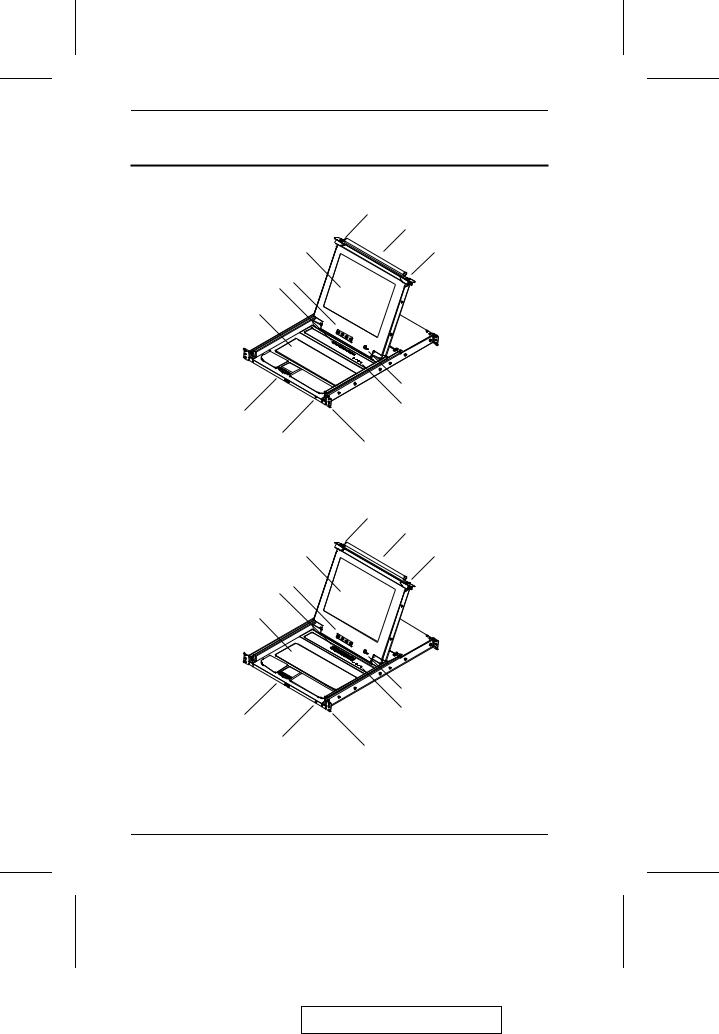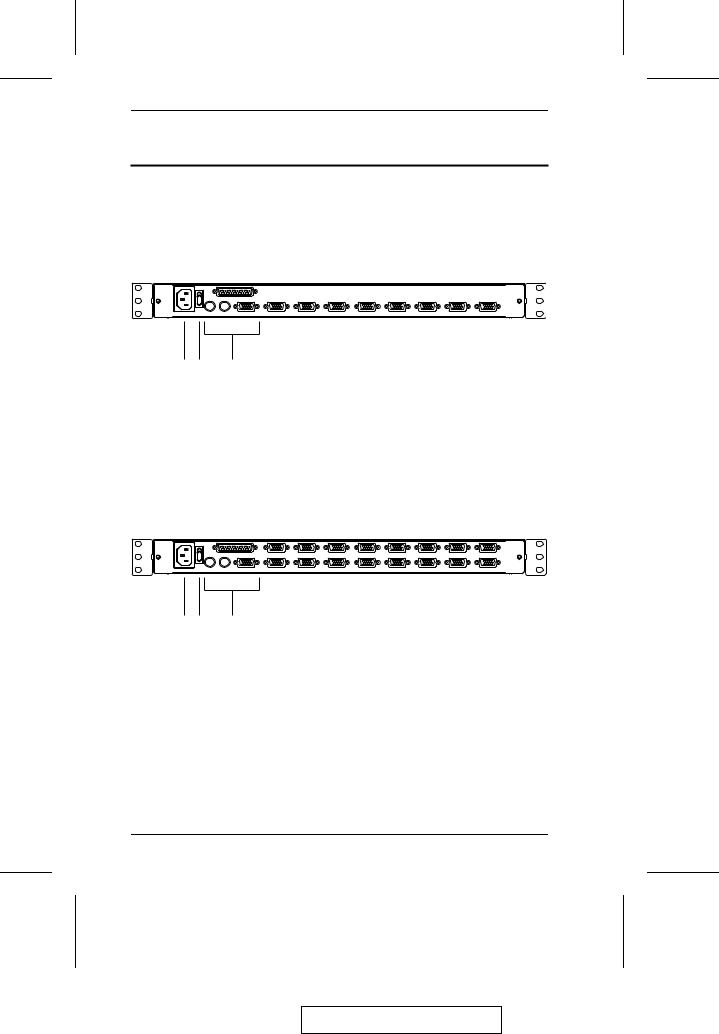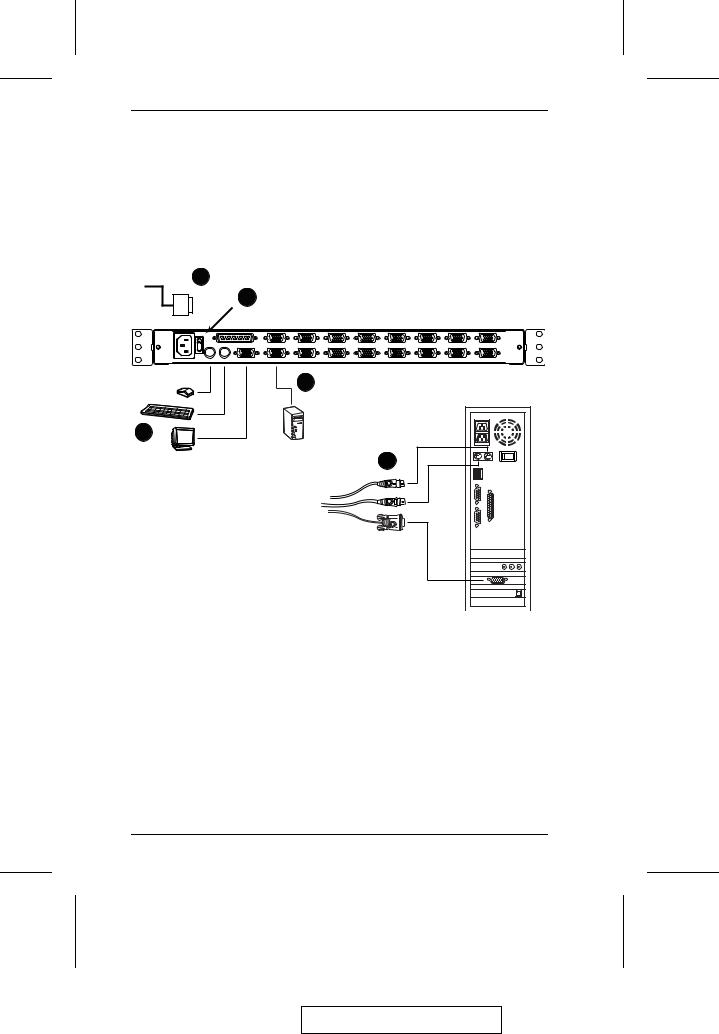ATEN CL-1208, CL-1216 User Manual

User Manual
CL-1208 CL-1216
2005-09-09

Warning!
This is a class A product. In a domestic environment this product may cause radio interference in which case the user may be required to take adequate measures.
This equipment has been tested and found to comply with the limits for a Class A digital device, pursuant to Part 15 of the FCC Rules. These limits are designed to provide reasonable protection against harmful interference when the equipment is operated in a commercial environment. This equipment generates, uses and can radiate radio frequency energy and, if not installed and used in accordance with the instruction manual, may cause harmful interference to radio communications. Operation of this equipment in a residential area is likely to cause harmful interference in which case the user will be required to correct the interference at his own expense.
2005-09-09

CL-1208 / CL-1216 User Manual
Packing List
Basic Package
The basic CL-1208 / CL-1216 package consists of the following equipment:
M1 CL-1208 / CL-1216 KVM Switch with Standard Rack Mounting Kit
M2 Custom KVM Cable Sets (2L-5202P)
M1 Firmware Upgrade Cable
M1 Power Cord
M1 User Manual
M1 Quick Start Guide
Optional Equipment
Depending on any optional equipment that you may have purchased, one of the following may be included in your package:
MStandard Rack Mounting Kit - Long
MEasy-Installation Rack Mounting Kit - Short
MEasy-Installation Rack Mounting Kit - Long
Check to make sure that all the components are present and that nothing got damaged in shipping. If you encounter a problem, contact your dealer.
Read this manual thoroughly and follow the installation and operation procedures carefully to prevent any damage to the unit, and/or any of the devices connected to it.
© Copyright 2005 ATEN® International Co., Ltd.
Manual Part No. PAPE-0246-100G
Printed in Taiwan 04/2005
All brand names and trademarks are the registered property of their respective owners.
iii
2005-09-09

CL-1208 / CL-1216 User Manual
Notes:
iv
2005-09-09

|
CL-1208 / CL-1216 User Manual |
Contents |
|
1. Introduction |
|
Overview . . . . . . . . . . . . . . . . . |
. . . . . . . . . . . . . . 1 |
Features . . . . . . . . . . . . . . . . . . |
. . . . . . . . . . . . . . 3 |
Hardware Requirements . . . . . . . . . |
. . . . . . . . . . . . . . 4 |
Computers . . . . . . . . . . . . . . |
. . . . . . . . . . . . . . 4 |
Cables . . . . . . . . . . . . . . . . |
. . . . . . . . . . . . . . 4 |
CL-1208 / CL-1216BL Front View . . . |
. . . . . . . . . . . . . . 6 |
CL-1208 / CL-1216 Rear View . . . . . |
. . . . . . . . . . . . . . 8 |
2. Installation
Before you Begin . . . . . . . . . . . . . . . . . . . . . . . . . . . 11
Single Stage Installation . . . . . . . . . . . . . . . . . . . . . . . 11
Daisy Chaining . . . . . . . . . . . . . . . . . . . . . . . . . . . . 13
3. Basic Operation |
|
Opening the Console . . . . . . . . . . . . . . . . . . . . . . . . . |
17 |
Closing the Console . . . . . . . . . . . . . . . . . . . . . . . . . |
18 |
LCD OSD Configuration . . . . . . . . . . . . . . . . . . . . . . . |
19 |
The LCD Buttons . . . . . . . . . . . . . . . . . . . . . . . . |
19 |
The Adjustment Settings . . . . . . . . . . . . . . . . . . . . . |
20 |
Port Selection . . . . . . . . . . . . . . . . . . . . . . . . . . . . . |
21 |
Manual Port Switching . . . . . . . . . . . . . . . . . . . . . |
21 |
Hot Plugging . . . . . . . . . . . . . . . . . . . . . . . . . . . . . |
22 |
Switching Station Positions . . . . . . . . . . . . . . . . . . . |
22 |
Hot Plugging CPU Ports . . . . . . . . . . . . . . . . . . . . . |
22 |
Powering Off and Restarting . . . . . . . . . . . . . . . . . . . . . |
23 |
Port ID Numbering . . . . . . . . . . . . . . . . . . . . . . . . . . |
24 |
4. OSD Operation
OSD Overview . . . . . . . . . . . . . . . . . . . . . . . . . . . . 25
OSD Navigation . . . . . . . . . . . . . . . . . . . . . . . . . . . 27
OSD Main Screen Headings . . . . . . . . . . . . . . . . . . . . . 27
OSD Functions . . . . . . . . . . . . . . . . . . . . . . . . . . . . 28
F1 GOTO: . . . . . . . . . . . . . . . . . . . . . . . . . . . . 28
F2 LIST: . . . . . . . . . . . . . . . . . . . . . . . . . . . . . 29
F3 SET: . . . . . . . . . . . . . . . . . . . . . . . . . . . . . 30
F4 ADM: . . . . . . . . . . . . . . . . . . . . . . . . . . . . . 32
v
2005-09-09

CL-1208 / CL-1216 User Manual |
|
F5 SKP: . . . . . . . . . . . . . . . . . . . . . . . . . . . . . |
36 |
F6 BRC: . . . . . . . . . . . . . . . . . . . . . . . . . . . . . |
37 |
F7 SCAN: . . . . . . . . . . . . . . . . . . . . . . . . . . . . |
38 |
F8 LOUT: . . . . . . . . . . . . . . . . . . . . . . . . . . . . |
39 |
5. Hotkey Operation |
|
Hotkey Port Access . . . . . . . . . . . . . . . . . . . . . . . . . |
41 |
Invoking Hotkey Mode . . . . . . . . . . . . . . . . . . . . . |
41 |
Selecting the Active Port . . . . . . . . . . . . . . . . . . . . |
42 |
Auto Scanning . . . . . . . . . . . . . . . . . . . . . . . . . . |
43 |
Skip Mode . . . . . . . . . . . . . . . . . . . . . . . . . . . . |
45 |
Hotkey Beeper Control . . . . . . . . . . . . . . . . . . . . . . . . |
46 |
Hotkey Summary Table . . . . . . . . . . . . . . . . . . . . . . . |
47 |
6. The Firmware Upgrade Utility |
|
Preparation . . . . . . . . . . . . . . . . . . . . . . . . . . . . . . |
50 |
Starting the Upgrade . . . . . . . . . . . . . . . . . . . . . . . . . |
51 |
Upgrade Succeeded . . . . . . . . . . . . . . . . . . . . . . . |
54 |
Upgrade Failed . . . . . . . . . . . . . . . . . . . . . . . . . . |
54 |
Firmware Upgrade Recovery . . . . . . . . . . . . . . . . . . . . |
55 |
Appendix |
|
Connection Tables . . . . . . . . . . . . . . . . . . . . . . . . . . |
57 |
CL-1208 + ACS-1208A . . . . . . . . . . . . . . . . . . . . . |
57 |
CL-1216 + ACS-1216A . . . . . . . . . . . . . . . . . . . . . |
57 |
OSD Factory Default Settings . . . . . . . . . . . . . . . . . . . . |
58 |
Clear Login Information . . . . . . . . . . . . . . . . . . . . . . . |
59 |
Rack Mounting . . . . . . . . . . . . . . . . . . . . . . . . . . . . |
60 |
Standard Rack Mounting . . . . . . . . . . . . . . . . . . . . |
60 |
Optional Rack Mounting . . . . . . . . . . . . . . . . . . . . |
61 |
Specifications . . . . . . . . . . . . . . . . . . . . . . . . . . . . . |
64 |
Troubleshooting . . . . . . . . . . . . . . . . . . . . . . . . . . . |
65 |
Limited Warranty . . . . . . . . . . . . . . . . . . . . . . . . . . . |
65 |
vi
2005-09-09

CL-1208 / CL-1216 User Manual
About This Manual
This User Manual is provided to help you get the most from your CL-1208 / CL-1216 system. It covers all aspects of installation, configuration and operation. An overview of the information found in the manual is provided below.
Overview
Chapter 1, Introduction, introduces you to the CL-1208 / CL-1216 System. Its purpose, features and benefits are presented, and its front and back panel components are described.
Chapter 2, Installation describes how to set up your installation — from a basic single stage hookup to a complete 32 switch daisy chained operation.
Chapter 3, Basic Operation explains the fundamental concepts involved in operating the CL-1208 / CL-1216.
Chapter 4, OSD Operation, provides a complete description of the CL-1208 / CL-1216’s OSD (On Screen Display), and how to work with it.
Chapter 5, Hotkey Operation, details all of the concepts and procedures involved in the Hotkey operation of your CL-1208 / CL-1216 installation.
Chapter 6, The Firmware Upgrade Utility, explains how to use this utility to upgrade the CL-1208 / CL-1216’s firmware with the latest available versions.
An Appendix at the end of the manual provides specifications and other technical information regarding the CL-1208 / CL-1216.
vii
2005-09-09

CL-1208 / CL-1216 User Manual
Conventions
This manual uses the following typographical conventions:
Courier |
Indicates text that you should key in. |
[ ] |
Indicates keys you should press. For example, [Enter] means to |
|
press the Enter key. If keys need to be chorded, they appear |
|
together in the same bracket with a plus sign between them: |
|
[Ctrl+Alt]. |
1.Numbered lists represent procedures with sequential steps.
MBullet lists provide information, but do not involve sequential steps.
→Indicates movement through a series. For example, Start →Run means to open the Start menu, and then select Run.
Indicates critical information.
viii
2005-09-09

Chapter 1.
Introduction
Overview
The Master View CL-1208 / CL-1216 KVM Switch is a control unit that allows access to multiple computers from a single KVM (keyboard, monitor, and mouse), console. Before the development of the Master View, the only way to control multiple computer configurations from a single console was through a complex and costly network system. Now, with the Master View CL-1208 / CL-1216, you can easily access multiple computers in a cost effective manner.
A single Master View CL-1208 or CL-1216 can control up to 8 or 16 computers, respectively. As many as 31 additional Master View units can be daisy chained to each other, so that up to 256 (CL-1208 + ACS-1208A) or 512 (CL-1216 + ACS-1216A) computers can all be controlled from a single keyboard-monitor-mouse console.
The Master View CL-1208 / CL-1216 offers a space-saving, streamlined approach to KVM switch technology by integrating a keyboard, LCD monitor, and touchpad in a Slideaway™ housing. The LCD display is built into the cover; the keyboard and touchpad are built into the base. Slide the KVM module section out; flip the cover up; and you are ready to go to work. When finished, flip the cover down and slide the KVM module away.
For further convenience, the Slideaway™ housing is 1U high for easy rack mounting. The CL-1208 / CL-1216 also features high density 15 pin connectors instead of the usual 25 pin connectors. This space-saving innovation allows a full, 16 port switch to be installed in a 1U system rack. Because of its modular design, the KVM section can be detached from the switch section.
Your CL-1208 / CL-1216 investment is protected by an included Firmware Upgrade Utility. You can stay current with the latest functionality improvements by downloading firmware update files from our website as they become available, and using the utility to quickly and conveniently perform the upgrade.
1
2005-09-09

CL-1208 / CL-1216 User Manual
Setup is fast and easy; plugging cables into their appropriate ports is all that is entailed. Because the CL-1208 / CL-1216 intercepts keyboard input directly, there is no software to configure; no need to get involved in complex installation routines; nor any need to be concerned with incompatibility problems.
Access to any computer connected to the installation is easily accomplished either by entering Hotkey combinations from the keyboard, or by means of a powerful, mouse driven, OSD (On Screen Display) menu system. A convenient Auto Scan feature also permits automatic scanning and monitoring of the activities of all computers running on the installation one by one.
There is no better way to save time and money than with a Master View CL-1208 / CL-1216 installation. By using the Master View CL-1208 / CL-1216 with its Slideaway™ console to manage your installation, you: (1) eliminate the expense of having to purchase a separate keyboard, monitor, and mouse for each computer; (2) save all the space those extra components would take up; (3) save the space that a keyboard, monitor, and mouse would take with a standard KVM switch; (4) save on energy costs; and (5) eliminate the inconvenience and wasted effort involved in constantly moving from one computer to another.
2
2005-09-09

Introduction
Features
MIntegrated KVM console with 15"or 17" LCD monitor - in a Slideaway™ housing
MSlideaway™ housing is less than 1U - with top and bottom clearance for smooth operation in a 1U high system rack.
MSpace saving technology - two consoles (one bus) controls up to 8 (CL-1208) or 16 (CL-1216) computers.
MDaisy chain up to 31 additional units - control up to 512 computers from the switch’s integrated Slideaway™ console.
MNo software required - convenient computer selection via Hotkeys and mouse driven intuitive On Screen Display (OSD) menus.
MAuto Scan feature for monitoring user-selected computers.
MBroadcast support - commands from the keyboard can be broadcast to all available computers on the installation.
MHot Pluggable - add or remove computers without having to power down the switch.
MTwo level password security - only authorized users view and control the computers - up to four users plus an administrator with separate profiles for each.
MDDC Emulation of the LCD Monitor - VGA settings of every connected computer are automatically adjusted for optimal output to the LCD Monitor.
MUpgradable firmware.
3
2005-09-09

CL-1208 / CL-1216 User Manual
Hardware Requirements
Computers
The following equipment must be installed on each computer:
MA VGA, SVGA or Multisync card.
Note: The integrated LCD monitor’s maximum resolution is
1024 x 768 (15") or 1280 x 1024 (17"). Make sure that none of the computer’s resolution settings exceed the LCD monitor’s maximum resolution.
MA 6-pin mini-DIN (PS/2 style) mouse port.*
MEither a 6-pin mini-DIN (PS/2 Style) keyboard port with +5V DC on pin 4 and Ground on pin 3, or a 5-pin DIN (AT Style) keyboard port with +5V DC on pin 5 and ground on pin 4.*
*See the note under Cables on p. 5.
Cables
Substandard cables may damage the connected devices or degrade overall performance. For optimum signal integrity and to simplify the layout, we strongly recommend that you use the high quality CS Custom Cable sets described below:
Function |
CS Part Number |
KVM Switch to KVM Switch (Daisy Chaining) |
2L-1700 - 0.6 m |
|
2L-1701 - 1.8 m |
|
|
KVM Switch to Computer (PS/2 Connection) |
2L-5201P - 1.2 m |
|
2L-5202P - 1.8 m |
|
2L-5203P - 3.0 m |
|
2L-5206P - 6.0 m |
|
|
KVM Switch to Computer (USB Connection) |
2L-5202UP - 1.8 m |
|
2L-5203UP - 3.0 m |
|
2L-5206UP - 6.0 m |
|
|
4
2005-09-09

Introduction
Note: 1. The CL-1208 / CL-1216 does not support serial mice. You cannot use Serial-to-PS/2 adapters with the cables. Attempts to do so will not work.
2.If your computer uses an AT style keyboard socket you will need to purchase a PS/2-to-AT keyboard adapter (Part No. 2A-106, or any standard keyboard adapter), in order to plug the cable into the computer’s keyboard port.
5
2005-09-09

CL-1208 / CL-1216 User Manual
CL-1208 / CL-1216BL Front View
13
1
2 |
13 |
4 & 5 3
6
|
12 |
7 |
10 & 11 |
|
8
9
13
1
2 |
13 |
4 & 5 3
6
|
12 |
7 |
10 & 11 |
|
|
|
8 |
|
9 |
6
2005-09-09

|
|
Introduction |
|
|
|
1 |
Handle |
Pull to slide the KVM module out; push to slide the module |
|
|
in (see item 13 in this table). |
|
|
|
2 |
LCD Display |
After sliding the KVM module out, flip up the cover to |
|
|
access the LCD monitor. |
|
|
|
3 |
LCD Controls |
The LCD On/Off switch is located here, as well as buttons |
|
|
to control the position and picture settings of the LCD |
|
|
display. See p. 19, for details. |
|
|
|
4 |
Port Switches |
Press a switch to bring the KVM focus to the computer |
|
|
attached to its corresponding port. See p. 21 for details. |
|
|
|
5 |
Port LEDs |
Two Port LEDs are built into the Port Switches. The one on |
|
|
the left is the On Line LED; the one on the right is the |
|
|
Selected Port LED: |
|
|
M An On Line LED lights ORANGE to indicate that the |
|
|
computer attached to its corresponding port is up and |
|
|
running. |
|
|
M A Selected LED lights GREEN to indicate that the |
|
|
computer attached to its corresponding port is the one |
|
|
that has the KVM focus. The LED is steady under normal |
|
|
conditions, but flashes when its port is accessed under |
|
|
Auto Scan Mode (see p. 38). |
|
|
|
6 |
Keyboard |
|
|
|
|
7 |
Touchpad |
|
|
|
|
8 |
Power LED |
Lights BLUE to indicate that the unit is receiving power. |
|
|
|
9 |
Rack Mounting |
The rack mounting tabs located at each corner of the unit |
|
Tabs |
secure the chassis to a system rack. Refer to the Appendix |
|
|
(p. 60), for rack mounting details. |
|
|
|
10 |
Lock LEDs |
The Num Lock, Caps Lock, Scroll Lock LEDs are located here. |
|
|
|
11 |
Reset Switch |
Located to the right of the Lock LEDs. Press this recessed |
|
|
switch in with a thin object to perform a system reset. |
|
|
|
12 |
Firmware |
M Firmware Upgrade Port: The Firmware Upgrade Cable |
|
Upgrade |
that transfers the firmware upgrade data from the |
|
Section |
administrator’s computer to the CL-1208 / CL-1216 plugs |
|
|
into this connector. |
|
|
M Firmware Upgrade Switch: During normal operation |
|
|
this switch should be in the NORMAL position. (See p. 49 |
|
|
for firmware upgrading details.) |
|
|
|
13 |
Slide Release |
In order to bring the console out, you must first release it by |
|
|
sliding these tabs to the inside. See p. 17 for details on |
|
|
sliding the console in and out. |
|
|
|
|
|
|
|
|
7 |
2005-09-09

CL-1208 / CL-1216 User Manual
CL-1208 / CL-1216 Rear View
1 |
2 |
||
|
|
|
|
|
|
|
|
|
|
|
|
3 |
4 |
5 |
1 |
2 |
||
|
|
|
|
|
|
|
|
|
|
|
|
3 |
4 |
5 |
8
2005-09-09

Introduction
1 |
Daisy Chain |
When Daisy Chaining Units, the cable plugs in here. |
|
Port |
|
|
|
|
2 |
CPU Port |
The cables that link to the computers plug in here. |
|
Section |
|
|
|
Note: The shape of these 15-pin connectors has been |
|
|
specifically modified so that only KVM cables designed to |
|
|
work with this switch can plug in (see the Cables section on |
|
|
p. 4, for details). Do NOT attempt to use ordinary 15 pin |
|
|
VGA connector cables to link these ports to the computers. |
|
|
|
3 |
Power Socket |
This is a standard 3 prong AC power socket. The power |
|
|
cord from an AC source plugs in here. |
|
|
|
4 |
Power Switch |
This is a standard rocker switch that powers the unit On |
|
|
and Off. |
|
|
|
5 |
External |
For flexibility and convenience, the CL-1208 / CL-1216 |
|
Console |
supports an independent, external, KVM console. The |
|
Section |
external console’s keyboard, monitor, and mouse cables |
|
|
plug in here. |
|
|
|
9
2005-09-09

CL-1208 / CL-1216 User Manual
Notes:
10
2005-09-09

Chapter 2.
Installation
Before you Begin
1.Make sure that power to all the devices you will be connecting up have been turned off. You must unplug the power cords of any computers that have the Keyboard Power On function.
Otherwise, the switch will receive power from the computer.
2.To prevent damage to your installation make sure that all devices
Single Stage Installation
In a Single Stage installation, there are no additional switches daisy chained down from the first unit. To set up a single stage installation, refer to the installation diagram on the next page (the numbers in the diagram correspond to the numbers of the installation steps), and do the following:
1.Plug your external console’s keyboard, monitor, and mouse into the Console Ports located on the switch’s rear panel. The ports are color coded and marked with an appropriate icon to indicate themselves.
Note: This step is optional.
2.For each of the computers you are installing, use a KVM cable set (as described in the Cables section on p. 4), to connect any available CPU Port to the computer’s keyboard, video and mouse ports.
Note: Ignore the Daisy Chain Port at this time. It is only used when daisy chaining additional Master View units. Daisy chaining is described in the next section.
3.Use the Power cord provided with this package to connect the switch’s Power Socket to an AC power source.
11
2005-09-09

CL-1208 / CL-1216 User Manual
4.Power on the switch.
5.After the switch is powered on, power on the computers.
3
4
2
1
2
12
2005-09-09

Installation
Daisy Chaining
To control even more computers, up to 31 Master View ACS-1208A / ACS-1216A units can be daisy chained down from the CL-1208 / CL-1216.
Note: It would be unnecessarily wasteful and expensive to use CL-1208 / CL-1216 switches for daisy chaining since there is no point in having consoles on the chained switches. Therefore, ACS-1208A and ACS-1216A switches are used instead.
The ACS-1208A and ACS-1216A are similar to the CL-1208 and CL-1216, except that they come in standard housings without the built in Slideaway™ console.
As many as 256 (CL-1208) or 512 (CL-1216) computers can be controlled from the unit’s integrated Slideaway™ console in a complete installation. Tables showing the relation between the number of computers and the number of Master View units needed to control them are provided on p. 57 in the Appendix.
To set up a daisy chained installation, refer to the daisy chain installation diagram on p. 15, and do the following:
1.Make sure that power to all the devices you will be connecting up has been turned off.
2.Use a daisy chain cable set (described in the Cables section, p. 4), to connect the Chain Out port of the parent unit to the Chain In port of the child unit (First Station Out to Second Station In, Second Station Out to Third Station In, etc.).
3.Use KVM cable sets (described in the Cables section of the ACS-1208A / ACS-1216A User Manual), to connect any available CPU Port on the daisy chained switch to the keyboard, video and mouse ports of the computers you are installing.
4.Repeat the above steps for any additional Master View units you wish to add to the chain.
13
2005-09-09

CL-1208 / CL-1216 User Manual
5. Power up the installation according to the following procedure: a) Power on the First Station (CL-1208 or CL-1216).
Wait a few seconds for the unit to ascertain its Station ID.
b)Plug in the power adapters for each daisy chained Station on the installation in turn (Second Station, then Third Station, etc.). Each ACS-1208A / ACS-1216A has a LED display on its front panel to indicate its Station ID (the Station ID for the First Stage unit is 01, the ID for the Second Stage unit is 02, the ID for the Third Stage unit is 03, etc.).
In each case, wait for the Station ID to be ascertained and displayed on the Station ID LED before plugging in the next Station.
c) After all the Stations are up, power on the computers.
14
2005-09-09
